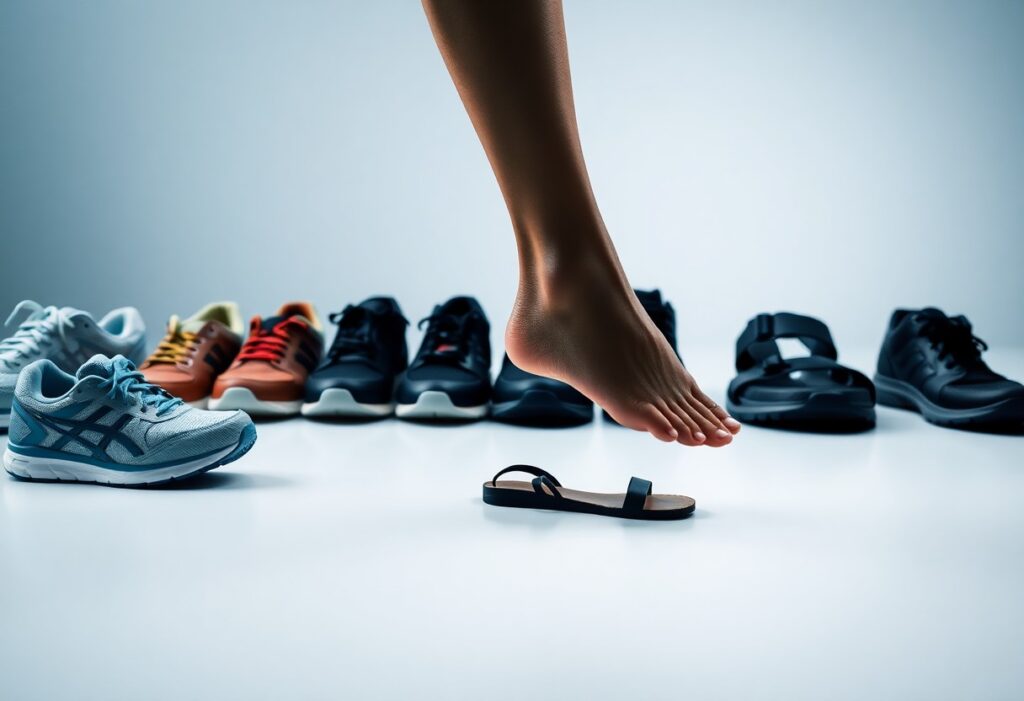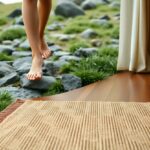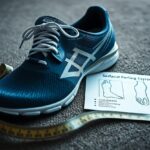
Every step you take is influenced by your choice of footwear, which can either enhance your foot health or contribute to serious discomfort. A common misconception is that shoes with enhanced cushioning and support are the solution for foot pain; however, many traditional shoe designs may actually exacerbate underlying issues. Dr. Alissa Kuizinas, a well-regarded podiatrist from Massachusetts, advocates for barefoot shoes or minimalistic footwear, asserting that these options promote stronger, healthier feet. By selecting footwear that allows your feet to function naturally, you can significantly decrease the likelihood of developing foot-related problems and enhance your overall foot wellness.
Understanding the Harmful Effects of Traditional Footwear on Foot Health
Traditional shoes may offer fleeting comfort, but they often intensify existing foot conditions and introduce new complications, as Dr. Alissa Kuizinas highlights. She emphasizes that the sprawling $133 billion shoe industry frequently prioritizes aesthetics and profit margins over actual foot health, leading to designs that can constrict and weaken your feet over time. This reliance on conventional footwear creates a vicious cycle that undermines foot health, potentially leading to chronic issues that could have been prevented with more thoughtful shoe choices.
Unpacking the Shoe Industry’s Ineffective Approaches to Foot Health
The crux of this issue lies in the shoe industry’s misguided methods for addressing foot health. Their focus tends to center around adding excessive cushioning, rigid support, and inflexible construction, often disregarding the root causes of foot discomfort. This approach fosters a dependence on shoes that could ultimately compromise your foot health in the long run, resulting in various complications that are avoidable with better design principles rooted in functionality.
Identifying the Design Flaws in Conventional Footwear
Many traditional shoe designs feature narrow toe boxes, stiff soles, and excessive cushioning that can restrict natural foot movement, which may lead to weakened and dysfunctional feet. Dr. Kuizinas stresses that footwear should shield your feet from external hazards rather than impede their natural movement. An optimal shoe design prioritizes natural foot function and incorporates minimalist features, such as wider toe boxes, flexible and flat soles, and minimal cushioning, all of which are essential for promoting foot health.
By embracing barefoot shoes or minimalistic footwear, you can effectively fortify your feet and uplift your overall foot well-being. Dr. Kuizinas champions the philosophy of utilizing as little shoe as possible, allowing your feet to function naturally and move freely, which is vital for maintaining optimal foot mechanics and preventing injuries.
Recognizing the Critical Role of Natural Foot Movement in Health
Footwear that restricts your foot’s natural mobility can lead to a wide array of foot problems and significant discomfort. It’s essential to evaluate how your footwear choices impact your overall foot health and comfort levels, enabling you to make better-informed decisions that enhance your well-being.
Assessing the Connection Between Footwear and Foot Mobility
To fully grasp how shoes influence your foot’s mobility, it’s crucial to analyze the specific designs and characteristics of the footwear you select. Traditional shoes often include cushioning and support features that may inadvertently impede your foot’s natural movement, leading to weak and dysfunctional feet over time. This restriction can hinder your feet from developing the necessary strength and flexibility to thrive in daily activities.
Uncovering the Extensive Benefits of Unrestricted Foot Mobility
The advantages of allowing your feet to move naturally are vast, as strong feet are integral to your overall foot health. By opting for minimalistic shoes or barefoot footwear, you empower your feet to perform as they are designed to, fostering strength and resilience. Movement is vital for developing strong feet. When confined by conventional footwear, you risk encountering a range of foot issues and discomfort. Conversely, embracing minimalistic shoes or barefoot options can tremendously enhance your foot health by facilitating natural movement and promoting muscle strength. By selecting the right footwear, you can minimize your risk of developing foot problems and improve your overall foot wellness.
Exploring the Concept of Functional Footwear for Optimal Health
Understanding the principles of functional footwear is crucial, as these shoes prioritize both foot health and the allowance of natural movement. Functional shoes are thoughtfully designed to enable your feet to operate as they were intended, eliminating the need for excessive support or confinement.
Defining the Characteristics of Functional Footwear
Through extensive research and experimentation with various shoe styles, it becomes clear that functional footwear possesses distinctive features, including a wide toe box, flat and flexible soles, as well as minimal cushioning and support. These attributes empower your feet to move freely and naturally, thereby promoting stronger and more effective foot mechanics.
The Significant Benefits of Functional Footwear in Promoting Foot Health
Wearing functional shoes offers a multitude of benefits, such as increased foot strength, a lower risk of injury, and enhanced overall foot health. These shoes are designed to allow your feet to function as they were intended, resulting in stronger feet and better balance throughout your daily activities. Functionally designed footwear is crafted to support your feet without imposing unnecessary restrictions, enabling them to move and flex in a natural manner. This design philosophy cultivates optimal foot health and reduces the likelihood of developing foot ailments. By selecting functional shoes like barefoot shoes or minimalistic options, you actively promote healthy foot function and mitigate the risk of foot pain and injury. Transitioning to functional footwear may require a gradual adjustment, but the long-term benefits for your foot health are invaluable.
Key Features to Seek in Functional Footwear for Health Benefits
To achieve optimal foot health, it’s crucial to look for shoes that exhibit certain key features. Important attributes to consider include:
- Wide toe box
- Flat and flexible soles
- Minimal cushioning and support
Being attentive to these characteristics will greatly aid you in selecting shoes that encourage healthy foot function and support.
Understanding the Importance of Wide Toe Boxes and Flexible Soles for Comfort
A critical feature of functional footwear is a wide toe box, which allows your toes to spread naturally. This design helps to prevent toe jamming and other discomfort-related issues that may result in chronic foot pain and complications over time.
Recognizing the Necessity of Minimal Cushioning and Support in Footwear
In addition to a wide toe box, functional shoes should also incorporate minimal cushioning and support. This design principle enables your feet to move naturally while strengthening foot muscles, thereby reducing the risk of foot issues. It’s essential to emphasize that minimalistic footwear, such as barefoot shoes, can significantly enhance your foot health by allowing your feet to function freely. By choosing shoes with minimal cushioning and support, you can fortify muscle strength in your feet and lower the chances of injuries. This strategic choice not only improves your overall foot health but also diminishes the likelihood of experiencing chronic pain. Therefore, prioritizing footwear that allows your feet to move naturally without excessive cushioning or support is essential.
Transitioning to Functional Footwear: A Comprehensive Guide
Having recognized the importance of functional footwear, it’s time to initiate your transition. It’s a common misconception that more cushioning and support lead to greater comfort; instead, aim for minimalistic shoes or barefoot shoes that facilitate your feet’s natural functioning.
Practical Tips for a Successful Transition to Functional Footwear
Despite any initial concerns, start incorporating functional shoes into your everyday routine by following these practical suggestions:
- Start with short walks and gradually extend your distance
- Select shoes that feature a wide toe box and flat soles
- Choose minimal cushioning and support
Allow your feet ample time to adjust to the new shoes while simultaneously strengthening the muscles in your feet.
Highlighting the Necessity of Patience During Your Footwear Transition
The process of transitioning to functional footwear demands patience and a gradual approach. Shoes that are overly minimalist can induce discomfort and pain if your feet are not accustomed to them. It’s crucial to take a slow and steady path, allowing your feet to acclimate to the new footwear.
Footwear options such as barefoot shoes or minimalistic shoes can significantly benefit your foot health, but introducing them gradually is essential. Overuse or improper sizing may lead to injuries or persistent discomfort. The ultimate goal is to strengthen your foot muscles while improving your overall foot health, so patience is vital, and rushing through the transition can be counterproductive. The rewards will be considerable; expect enhanced balance, reduced pain, and stronger feet.
Fostering Strong and Functional Feet Through Thoughtful Footwear Choices
Even in a culture that often favors shoes with excessive cushioning and support, you can cultivate strong and functional feet by making informed footwear selections.
Examining the Connection Between Foot Strength and Overall Physical Health
In addition to various health considerations, foot strength is a vital component of your overall well-being, influencing your balance, posture, and movement capabilities.
How Functional Footwear Contributes to Foot Strength Development
Functionally designed shoes characterized by a wide toe box, flat and flexible soles, and minimal cushioning are essential for developing strong feet, as they facilitate natural movement. Indeed, wearing functional shoes or barefoot shoes can greatly assist in building stronger foot muscles and enhancing your overall foot health. By allowing your feet the freedom to move and function as intended, you can minimize the risk of foot problems while optimizing your balance and stability. As you make the switch to minimalistic shoes, you should look forward to improvements in your walking technique and an overall enhancement in your sense of well-being.
By proactively managing your foot health, you can choose shoes that support your feet’s natural functions rather than hinder them. Selecting barefoot shoes or minimalistic options that allow your feet to operate freely will encourage strength and stability over time. Start your journey by seeking footwear with a wide toe box, flat and flexible soles, and minimal cushioning and support, while being patient as you transition to a more natural walking style.
The Article A Podiatrist’s Guide to How Shoes Affect Your Foot Health appeared first on My Shoes Finder
The Article How Shoes Impact Your Foot Health: A Podiatrist’s Insights Was Found On https://limitsofstrategy.com
The Article Shoes and Foot Health: Insights from a Podiatrist First Appeared ON
: https://ad4sc.com





Comments are closed